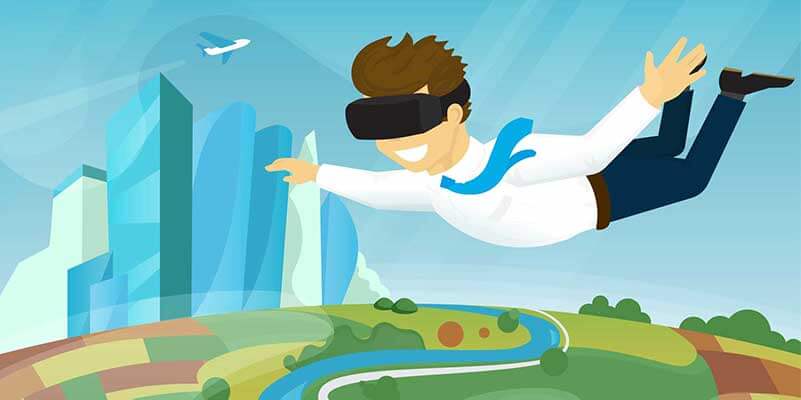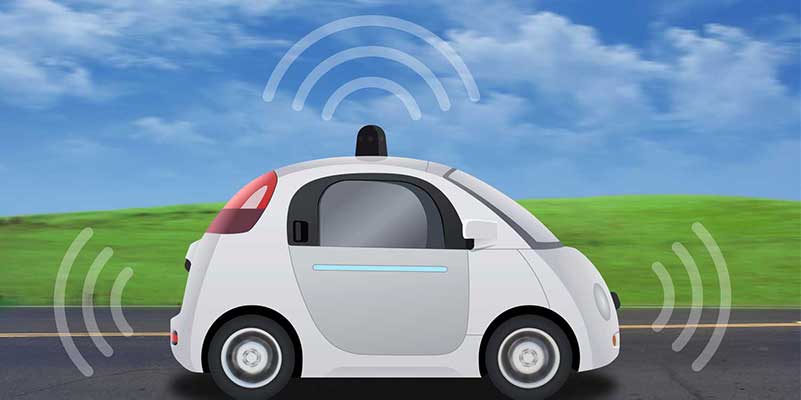Technology is not always about revolutionizing large-scale manufacturing and production or sending a man to the moon. Sometimes, little pieces of innovation can put the world on the course of revolution. See the integrated circuit, for instance. Microscopic transistors on a single board have transformed the way we live in the form of computers, and later, on the internet.
Today, in our next instalment of “What’s Hot in Technology,” we look at similar innovations which are set to impact the world in a radical manner. We will have a look at enhanced customer experiences, thanks to the internet of things and sensors that alert you when you are exposed to radiation. We look at computer algorithms which can define creativity in classic paintings and a zoo where no animal will be real and no real animal will be captured! Yes! The technology of the 21st century is aiming consistently for nobler and sustainable things. Let us explore what’s hot in technology this week
1. The Internet of Things is delving deep into data to provide enhanced customer experience
Until recently, customer relationship management allowed companies to tap into specific information such as who responded to a specific campaign, who became a paying customer, and who called the most for support. It has allowed companies to get an overall estimate of consumer behavior. However, this is set to change soon. Courtesy of big data and the Internet of Things (IoT), we will see companies having a go at every intricate detail regarding customers’ actual experiences. They may easily know when you enter a store, the shelves you frequent, and even the amount of each kind of stuff you buy. Scary, isn’t it?’
The vivid view of end-to-end experiences is constantly changing the way people think about, calculate, and manage their customer relationships. The more information you integrate with the IoT, the more predictable you are. Take Waze, for instance. It is a popular crowd sourced driving app which provides people with real-time traffic information such as warnings about hidden police, congestion-free driving, best route possibilities, and much more. Now this app can only work when you disclose your location. Did you get the bottom line? In simpler words, the level of enhancement of customer experience is directly proportional to the disclosed information. Disney’s MyMagic+ is another such application in which the guests wear a MagicBand bracelet which discloses their location at all times. The guests also use another application called My Disney Experience to plan stuff such as rides, parades, and what not. Disney tracks this information, taps into their interests, and then sends in personalized suggestions to enhance their experiences.
The extent of application of the IoT is only limited by the expectation and acceptance of the customers over the kind of information they are willing to disclose and the level of experience they want to have. As this intersection evolves, the kind of experiences which can be recorded and analyzed by big data evolves with it. A popular way for getting a grasp of consumer experience journeys involves the documentation of the following:
- Awareness of the experience: How does the customer become aware of the existence of this customer experience?
- Signing up for the experience: How does the customer get access to this experience? Do they need to register or sign up?
- Start of the experience: When does the customer experience start?
- Engagement with the experience: How does the customer respond while engaging with the experience? What is important to the customer?
- Finalising the experience: How does the experience/engagement come to a conclusion?
- Reflection and feedback on the experience: How does the customer reflect on the experience? Do they leave feedback on social media?
This kind of analysis assumes heavy data mining, courtesy of big data and the IoT. This helps companies predict the course of action people will take and devise strategies accordingly. However, there is also a possibility of this information being misused to persuade people in buying stuff they don’t need! I believe the extent of information which we disclose is an element of choice which solely rests with us. Therefore, we should be mindful of the experiences we wish to have and not simply give in to temptation.
See also: Trending in Technology: Spotify, L’Oreal and Google
2. Virtual reality is going big: China will have its own virtual reality amusement park, with a virtual zoo!
Virtual reality has largely been a niche technology till now, but it has always been hot in technology. Some efforts have been made but apart from Facebook’s Oculus Rift and Samsung’s Gear VR, the entire arena of virtual reality has been limited to 3D movie experience and related entertainment stuff. Let me tell you that this is soon going to change.
According to Landmark Entertainment Group, virtual reality is the future of entertainment. The company plans to build an entire live experience in China which will include a virtual zoo and aquarium along with a virtual interactive museum and digital art gallery. The company already holds stakes in immersive entertainment experiences such as Universal’s Jurassic Park: The Ride and The Amazing Adventures of Spiderman 5D. Tentatively called Landmark Interactive Virtual Experience (L.I.V.E), it will offer 30% of its entertainment as virtual reality content. According to Tony Christopher, CEO and founder of the entertainment group, PETA loved the early presentations about the zoo.
I find this quite fascinating and ideal as the idea of having real animals in a zoo has been questioned for quite some time. This kind of offering could provide a new avenue where animals would no longer be raised in captivity for the amusement of people and be allowed to flourish in their natural habitats. I would love to see the idea come to fruition. Wouldn’t you? The project will cost around USD200 million (apart from the land and building) and has the support of a few private investors as well as the Government of China. Illustrations made by artist Syd Mead (Blade Runner, Tron, and Tomorrowland Hall fame) show visitors with no VR headsets but the organization confirmed that headsets would indeed be part of the experience. The location is still undecided but may be chosen from among the Chinese cities of Xi’an, Chengdu, and Wuhan. Well, I can’t wait for the zoo to come to “virtual life” Are you ready to have the Jurassic Park experience minus the gore?
3. A collision with a self-driving car? Google will publicly report the details!
In our previous posts where we discussed about self-driving cars, the prevailing opinion was that these would be accident-free and completely safe. However, that does not appear to be the case. News that was hot in technology this week is that Google has started publicly detailing accidents involving its driverless cars. It states that this is in response to the heightened concern about safety after reports flew in about accidents involving its driverless cars. These accidents will be detailed and reported on a monthly basis. The first report arrived last month in May where details about all prior accidents were reported. Google confidently claims that their cars were not at fault in any case! In most cases, the rear end of the car was involved, indicating the other party involved was at fault. The point which relieves me is that there have been only 12 minor accidents throughout this six-year project. More than 1.8 million miles have been driven involving both manual as well as autonomous driving.
I guess the aim is to calm public concerns. I also believe it is a sign of confidence from the tech giant that it believes in its calculations and technology and won’t allow the fault of others to smudge its own reputation. I think this confidence will come in handy when Google expands it test tracks to public roads in Mountain View, California. These tests will affirm whether the vehicles are ready for public use or not. There will be small tests in the beginning, where drivers will be present to take over when necessary. The speed limit will be a moderate 25 miles per hour. In our earlier posts, we have seen how the future of individual conveyance revolves around driverless and efficient vehicles which facilitate efficient driving along with the scope for multitasking. Google’s efforts to analyze information and conveying them to the public should be respected. Furthermore, even people should analyze and rectify their own little anomalies and aim for better efficiency. What do you think?
4. Can’t make out the difference between a Van Gogh and a Picasso? Don’t worry. This Machine Vision Algorithm will tell you which one is more creative!
Who would have thought that the algorithm for finding the most potent disease carriers as well as for differentiating one creative painting from another would be so similar? Yes, this latest development has been hot in technology for a while now. Creativity is a quality which differentiates humans from other life forms. Numerous thinkers have explored the attributes necessary for creative intelligence. Yet, one question has always baffled modern science nerds: Can AI reach a level where it understands human creativity? Finally, we have the answer, thanks to the work of Ahmed Elgammal and Babak Saleh from the Rutgers University in New Jersey. The duo has created a machine which may leave accomplished historians unemployed in the time to come.
Generally, the job of differentiating creative art is not easy. It requires an encyclopaedic knowledge of the history of art to start with. A historian must be able to spot novel features and recognize similar features in other paintings to determine their influence. So when one says that a computer algorithm can tell a creative painting from another then it is, well, a big deal. Elgammal and Saleh have put it to work on a database of 62000 pictures of fine art paintings to help it figure out the most creative paintings in history. Experts say that the results provide a new way to explore the history of art and the role creativity plays in the same. This ability to classify is based on the visual concepts these paintings generate, which are called classemes – efficient object category recognition tools. These are all sorts of attributes surrounding the paintings such as color, texture, a house, a church, a horse, a hair pin, and even higher features such as a walking person, a dead body, and so on.
The Machine Vision Algorithm analyzes a picture and produces a list of classemes that describes the painting. This list acts as a vector that defines the picture and can be used to compare the same against others. The algorithm is also supported by the recent rise of huge online databases of art. Machine Vision Algorithms need big databases to learn about complex paintings. Therefore, Elgammal and Saleh employ two large databases from the Wikiart website, which contains images and annotations on around 62,000 works of art throughout history. The basic idea is to treat the history of art as a network where each painting of the past links to a similar painting in the future. It is similar to finding the most influential person on a social network or the most potent carrier of a disease. The results have been pretty interesting. Many famous pictures such as Goya’s Christ Crucified and Monet’s Haystacks at Chailly at Sunrise come out as novel and influential. Other works such as Rodin’s 1889 sculpture of Danaid are deemed not creative.
The positive coincidence is that many historians agree with the results! This is a remarkable achievement according to me because the process in itself is very complex and getting such accurate automated results presents other opportunities for Machine Vision Algorithms. Such kind of data mining and analysis could be used in literature, sculpture, and even science when it comes to differentiating more potent properties from lesser ones. Although this is a remarkable achievement, I believe it will be interesting to see how the algorithm fares on other subjects of historical and scientific importance. Moreover, I believe that human monitoring should be enforced in the final stage of the results to ensure a truly unbiased and comprehensive analysis. What do you think?
5. Put these sensors on when you go out in the sun: They will tell you when you’re about to get sunburnt!
I guess with temperatures soaring across the globe, such a device would come as a relief to many, especially to those with skin conditions. Researchers at the Royal Melbourne Institute of Technology, Australia have developed a nicotine patch-sized wearable stretchable sensor which can be worn on the skin. The sensor is capable of detecting UV radiation and even dangerous gases. The device has been hot in technology this week and is creating quite a buzz all across the tech arena. The technology behind it can take an ordinary material such as zinc oxide (which is a key ingredient in sunscreen lotions) and turn it into an electric sensor patch which is thinner than a millimeter! This is then transferred on to a silicone rubber substrate (used in contact lenses) to make the sensor stretchy and mobile. This makes the sensor highly flexible and transparent compared to other wearable devices which employ hard materials engulfed in rubber substrates.
Researchers consider this as the USP of the product. You could even stick it on your wrist and go to the beach! This way, once the sensor is linked to your smartphone, you will easily be alerted about long exposure to harmful radiation and could prevent sunburns and other harmful skin conditions. Now here comes the awesome part where this device creates a lot of appeal: it is potentially quite cheap. The materials employed are very low cost (zinc oxide is produced on a large scale for sunscreen). Currently, efforts are being made by the team to add more functionality to the sensor so as to seamlessly integrate the device with the human body. As for me, I would love to own such a device which gives me vital information about exposure to harmful radiation. I am sure you will love to own it. However, we will have to wait for the product to arrive in stores.
Conclusion
Technology has always found ways to change, human behavior – sometimes for the worse and sometimes for the better. It is positive to see so much constructive work being done in the field of technology. I really like the way Google is stepping up its operations to achieve higher efficiency in its driverless cars and also making the public aware about the same. It will be quite remarkable to see the varied applications of the technical developments we discussed today. I would certainly love to visit the VR zoo when it finally opens! Wouldn’t you?
Until then, please feel free to share your opinion with us.
Share via:






